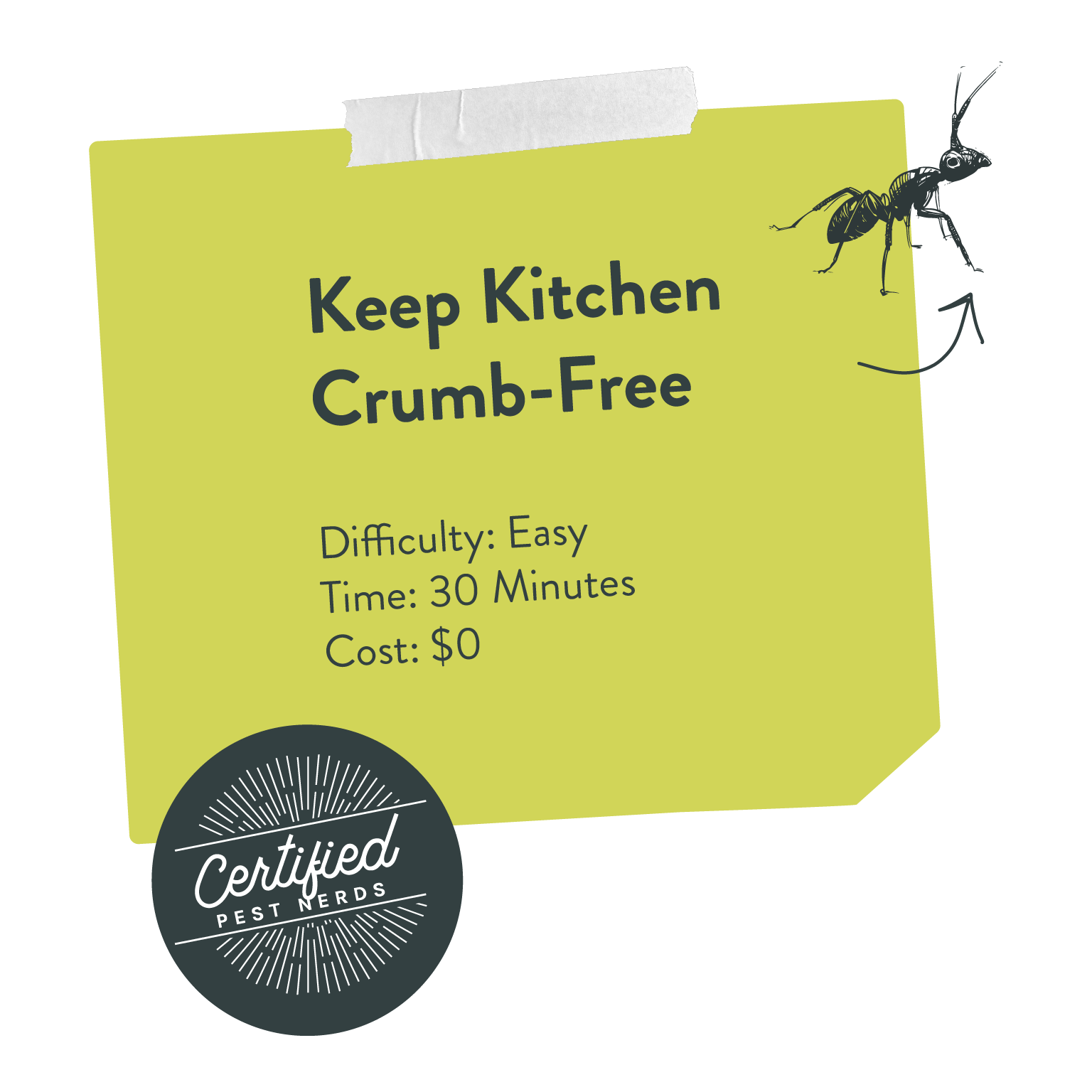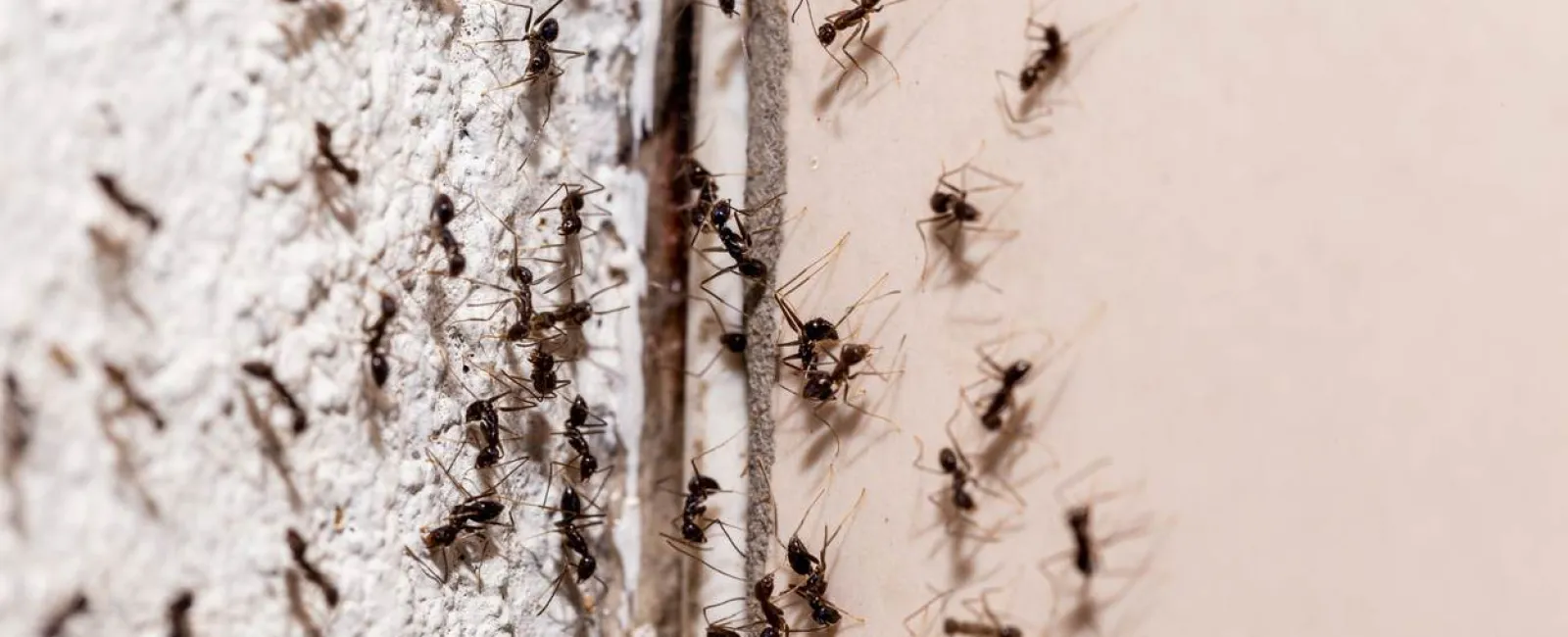Ant colonies tend to grow the most during spring and summer. The warmer temperatures make it easier for ants to remain active and reproduce. Keep an eye out for these common types of ant infestations in your home and around your property.
1. Acrobat Ants
Worker Size: 1/8 inch (about 3 millimeters)
Colors: Light brown, black, or brown and black
When disturbed, acrobat ants can raise their abdomen (rear body segment) above their thorax and head in a pose like a circus acrobat. These ants can forage up to 100 feet away from their nest, and you may see lines of them trailing up pipes, walls, and utility cables over a long distance. Acrobat ants have a noticeably heart-shaped abdomen.
2. Carpenter Ants
Worker Size: 5/8 inch (about 16 millimeters)
Colors: Black, red, or a combination of red and black
These ants are substantially larger than other common black ants (like little black ants and pavement ants). Carpenter ants get their name from the way they tunnel into wood to build their nests. Over time, this wood excavation can damage a home's framework or other wooden areas.
3. Field Ants
Worker Size: 1/8 to 3/8 inch (about 3 to 9 millimeters)
Colors: Black, red and black, red, brown, and yellowish-brown,
While these ants aren't likely to invade your home, they can wreak havoc on your landscaping. Field ant colonies build mounds outdoors over their nests. The mounds are usually comprised of grass, leaves, twigs, and other plant materials. Depending on the species, some field ants will build nests around home foundations and sidewalk cracks, whereas others will build nests along trees, fences, and rocks.
4. Little Black Ants
Worker Size: 1/16 inch (about 1.5 millimeters)
Colors: Dark brown to jet black
Little black ant nests are commonly found outdoors under rocks, logs, and lumber piles. Indoors, these ants tend to nest in masonry, wall voids, and woodwork (especially decaying wood). They feed on sweet or greasy foods alike and will also eat other insects.
5. Odorous House Ants
Worker Size: 1/16 to 1/8 inch (about 1.5 to 3 millimeters)
Colors: Brown to black
Odorous house ants are particularly fond of sweet foods and honeydew, a sugary liquid that aphids secrete when feeding on plant sap. These ants are attracted to a home's muggy areas and can often be found by water heaters, hot water pipes, and plumbing leaks. When these ants are crushed, they release an odor that many people relate to rotting coconut or bleu cheese.
6. Pavement Ants
Worker Size: 1/8 inch (about 3 millimeters)
Colors: Dark brown to blackish-brown
These ants commonly build nests underneath stones, below pavement cracks, or in masonry walls (walls with mortar). They're attracted to sweet, greasy, and oily foods and can contaminate your food if they infest it.
7. Pharaoh Ants
Colors: yellow or amber with a brown or black abdomen
Many people have mistakenly believed these ants were one of the plagues of Egypt during ancient times. This misconception earned these ants the name "pharaoh ants." While pharaoh ants most likely came from a region in Africa, it's unlikely they came directly from Egypt. Pharaoh ant colonies can come in "plague-like" sizes, numbering in the hundreds of thousands, and they can transmit harmful pathogens to people and pets if they manage to contaminate food.
8. Thief Ant, aka. "Grease Ant" or "Sugar Ant"
Worker Size: 1/16 to 3/32 inch (about 1.5 to 2.2 millimeters long)
Colors: Yellowish brown to dark brown
Thief ants are one of the smallest species of household ant. They are strongly attracted to foods that are sugary or greasy, which is why people commonly refer to them as "sugar ants" or "grease ants." The name "thief ant" comes from their tendency to steal food, larvae, and pupae from neighboring ant colonies.
Effective, Year-Round Ant Control
Get the help you need against stubborn ant invaders with the help of Greenix Pest Control. Our sustainable, proven methods provide consistent protection against ant infestations, giving you peace of mind all year long. Whether you're dealing with uninvited guests at your backyard barbecue or can't keep invaders out of the snack cabinet, the service pros at Greenix are equipped to eliminate ant colonies and keep them from coming back. Give us a call or request a free quote today!

DIY Ant Prevention Steps
1. Wipe down all countertops and cabinet surfaces.
2. Vacuum behind appliances.
3. Take out the trash daily.
4. Store food in airtight containers.
5. Don't leave dirty dishes overnight.
6. Clean your sink drain with vinegar & baking soda weekly.

